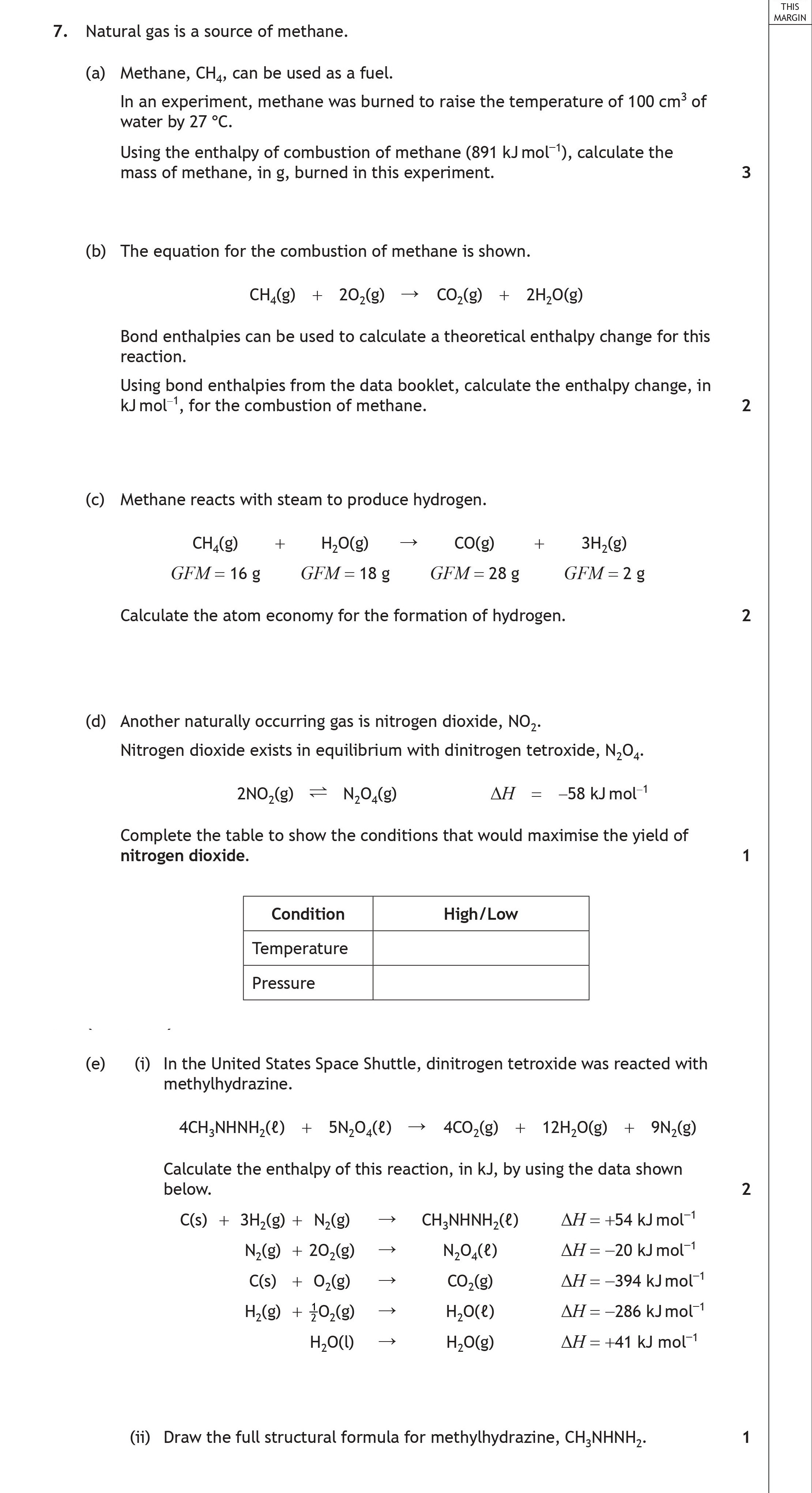Photo AI
Natural gas is a source of methane - Scottish Highers Chemistry - Question 7 - 2022
Question 7

Natural gas is a source of methane. (a) Methane, CH₄, can be used as a fuel. In an experiment, methane was burned to raise the temperature of 100 cm³ of water by 27... show full transcript
Worked Solution & Example Answer:Natural gas is a source of methane - Scottish Highers Chemistry - Question 7 - 2022
Step 1
Calculate the mass of methane burned in this experiment.
Answer
To find the mass of methane burned, we can use the formula: m = c imes m imes ext{ΔT} where:
- c = specific heat capacity of water (4.18 J g⁻¹ °C⁻¹)
- m = mass of water (100 cm³ of water means 100 g, as density of water is 1 g cm⁻³)
- ΔT = change in temperature (27 °C).
The energy absorbed by the water is:
Q = 100 g imes 4.18 ext{ J g⁻¹ °C⁻¹} imes 27 °C = 11286 J = 11.286 kJ.
Using the enthalpy of combustion of methane:
No. of moles of methane = Q / ΔH = 11.286 kJ / 891 kJ mol⁻¹ = 0.0127 mol.
To find the mass: Mass = no. of moles × molar mass of methane (16 g mol⁻¹) = 0.0127 mol × 16 g mol⁻¹ = 0.203 g.
Step 2
Calculate the enthalpy change for the combustion of methane using bond enthalpies.
Answer
The balanced equation for the combustion of methane is:
CH₄(g) + 2 O₂(g) → CO₂(g) + 2 H₂O(g).
Using bond enthalpies:
- Energy to break bonds in reactants:
- C-H bond (4 bonds): 4 × 412 kJ = 1648 kJ
- O=O bond (2 bonds): 2 × 498 kJ = 996 kJ
Total energy to break bonds = 1648 kJ + 996 kJ = 2644 kJ.
- Energy released in forming bonds in products:
- C=O bond (2 bonds): 2 × 804 kJ = 1608 kJ
- O-H bond (4 bonds): 4 × 463 kJ = 1852 kJ
Total energy released = 1608 kJ + 1852 kJ = 3460 kJ.
The theoretical enthalpy change:
ΔH = Energy broken - Energy formed = 2644 kJ - 3460 kJ = -816 kJ mol⁻¹.
Step 3
Calculate the atom economy for the formation of hydrogen.
Answer
The atom economy is calculated using the formula:
Atom economy = (Molar mass of desired product / Total molar mass of all products) × 100.
Here, the desired product is H₂, and the reaction is:
CH₄(g) + H₂O(g) ⇌ CO(g) + 3 H₂(g).
Molar mass of H₂ = 2 g/mol, and total molar mass = GFM from the equation.
Total = 4 (for CH₄) + 18 (for H₂O) = 22 g/mol.
Atom economy = (2 g / 22 g) × 100 = 9.09%.
Step 4
Step 5
Calculate the enthalpy of the reaction with methylhydrazine.
Answer
Using Hess's law, we find the enthalpy change for the reaction:
ΔH = [ΔH for products] - [ΔH for reactants]. The reaction is: 4 CH₄NH₃N(l) + 5 N₂O₄(l) → 4 CO₂(g) + 12 H₂O(g) + 9 N₂(g)
Total ΔH = [4 × (-393.5 kJ)] + [12 × (-576 kJ)] + [9 × 0] - [(4 × 54 kJ) + (5 × (-58 kJ))] = -4632 kJ.
Step 6
